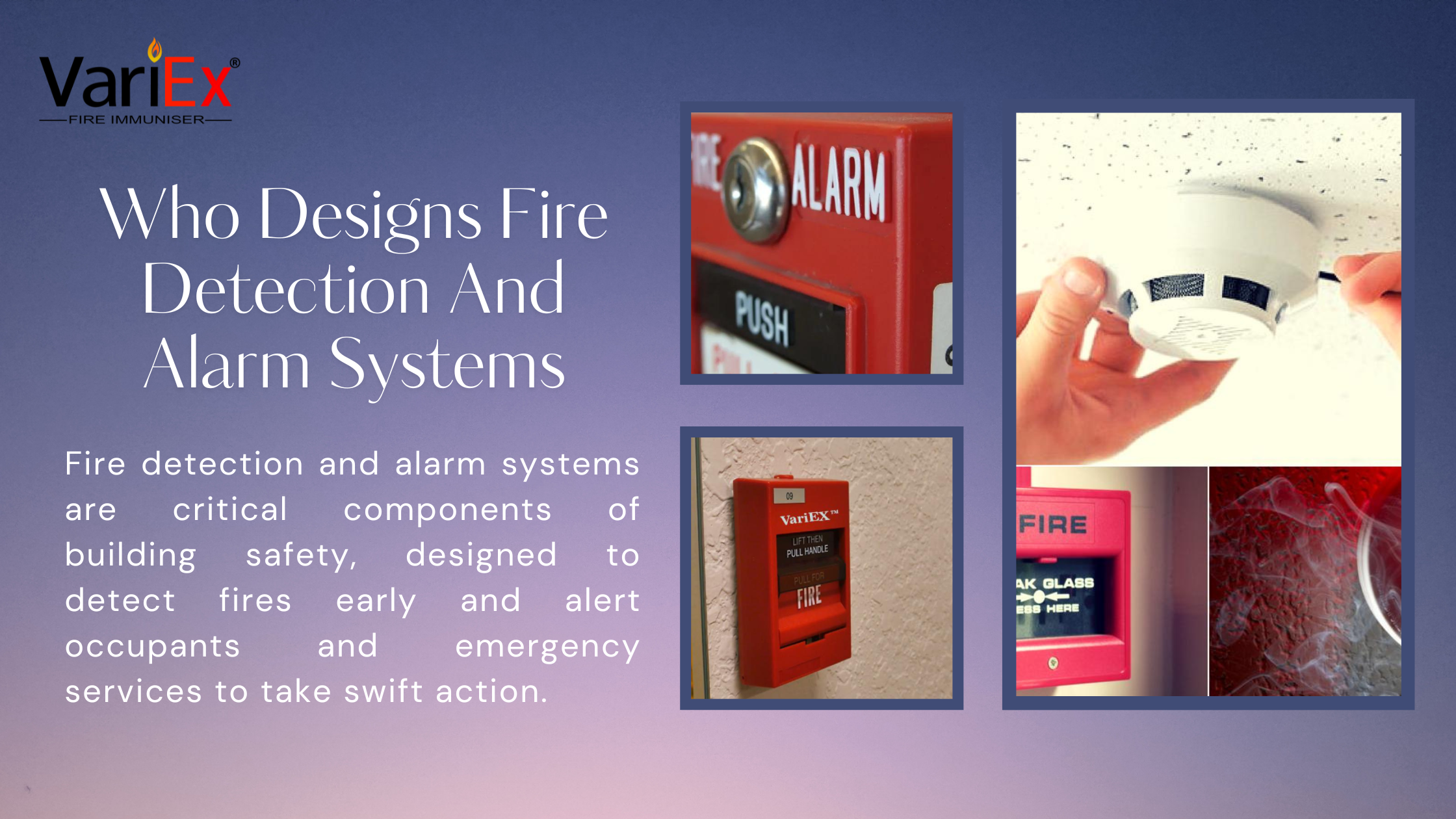![]()
Fire Immuniser
+91-7829629111
Email: info@variex.in
Varistor Technologies Pvt. Ltd.
Block-1, First Floor, Ardente Office One, Hoodi Circle, ITPL Main Road, Bengaluru, Karnataka 560048, IN
Who Designs Fire Detection And Alarm Systems
Who Designs Fire Detection And Alarm Systems
Fire detection and alarm systems are critical components of building safety, designed to detect fires early and alert occupants and emergency services to take swift action. These systems are essential in saving lives and minimizing property damage. The design of fire detection and alarm systems involves a multidisciplinary approach, encompassing various fields of expertise and requiring the collaboration of multiple professionals. This detailed exploration will cover who designs these systems, the qualifications they need, the process they follow, and the technologies they employ.
Key Professionals Involved in Designing Fire Detection and Alarm Systems
1. Fire Protection Engineers
Fire protection engineers play a pivotal role in designing fire detection and alarm systems. They specialize in understanding fire behavior, prevention, and suppression. Their responsibilities include:
- Risk Assessment: Evaluating the potential fire hazards in a building and determining the appropriate level of fire protection.
- System Design: Creating comprehensive fire detection and alarm systems tailored to the specific needs of a building, ensuring compliance with local codes and standards.
- Integration: Ensuring the fire detection and alarm systems are integrated seamlessly with other building systems, such as HVAC, electrical, and emergency lighting.
- Testing and Commissioning: Overseeing the installation and testing of the systems to ensure they function correctly.
2. Electrical Engineers
Electrical engineers are crucial in the design and implementation of fire detection and alarm systems, particularly concerning the electrical components. Their responsibilities include:
- System Layout: Designing the electrical layout for the fire detection and alarm systems, including wiring, power supply, and backup systems.
- Component Selection: Choosing appropriate sensors, alarms, control panels, and other electrical components based on the building's requirements.
- Compliance: Ensuring all electrical designs meet relevant safety standards and codes.
- Maintenance Planning: Developing plans for the regular maintenance and testing of electrical components to ensure long-term reliability.
3. System Integrators
System integrators are professionals who specialize in combining various subsystems into a unified system that operates seamlessly. In the context of fire detection and alarm systems, they:
- Component Integration: Ensure that all parts of the fire detection and alarm system work together efficiently, including sensors, control panels, and communication systems.
- Software Configuration: Set up the software that controls the fire detection and alarm systems, programming it to meet the specific needs of the building.
- Network Design: Design the network infrastructure that supports the fire detection and alarm systems, ensuring robust and reliable communication between components.
- Testing and Troubleshooting: Perform comprehensive testing to identify and resolve any issues before the system goes live.
4. Architects and Building Designers
Architects and building designers incorporate fire safety considerations into the overall design of a building. Their contributions include:
- Building Layout: Designing the building layout to facilitate effective fire detection and evacuation, including placement of exits, fire doors, and alarm stations.
- Aesthetic Integration: Ensuring that fire detection and alarm system components are integrated into the building design without compromising aesthetics.
- Code Compliance: Ensuring that the building design complies with all relevant fire safety codes and regulations.
- Collaboration: Working closely with fire protection engineers and other specialists to incorporate fire detection and alarm systems into the building design.
5. Manufacturers and Vendors
Manufacturers and vendors of fire detection and alarm system components provide the hardware and software necessary for these systems. Their roles include:
- Product Development: Designing and producing reliable and effective fire detection and alarm system components, such as smoke detectors, heat sensors, and control panels.
- Technical Support: Offering technical support and training to ensure proper installation and maintenance of their products.
- Research and Innovation: Continuously researching and developing new technologies to improve the effectiveness and reliability of fire detection and alarm systems.
- Standards Compliance: Ensuring that their products meet all relevant safety and performance standards.
Qualifications and Training for Designing Fire Detection and Alarm Systems
Educational Background
Designing fire detection and alarm systems requires a solid educational foundation in relevant fields. Key educational requirements include:
- Fire Protection Engineering: A degree in fire protection engineering or a related field is essential for fire protection engineers. These programs cover fire dynamics, fire prevention, fire detection, and suppression systems.
- Electrical Engineering: A degree in electrical engineering is crucial for those designing the electrical components of fire detection and alarm systems. These programs focus on circuit design, power systems, and control systems.
- Architecture: A degree in architecture is necessary for architects involved in the design process. Architectural programs emphasize building design, safety, and compliance with codes and standards.
Professional Certifications
In addition to formal education, professional certifications enhance the qualifications of those designing fire detection and alarm systems. Key certifications include:
- Professional Engineer (PE): Certification as a Professional Engineer is often required for fire protection and electrical engineers, demonstrating their competence and adherence to professional standards.
- Certified Fire Protection Specialist (CFPS): Offered by the National Fire Protection Association (NFPA), this certification is valuable for professionals specializing in fire protection.
- NICET Certification: The National Institute for Certification in Engineering Technologies (NICET) offers certifications for various levels of proficiency in fire alarm systems.
Continuing Education
The field of fire detection and alarm system design is continually evolving, necessitating ongoing education and training. Professionals must stay current with:
- Code Updates: Regular updates to fire safety codes and standards, such as those from NFPA and the International Code Council (ICC).
- Technological Advancements: New technologies and products that enhance the effectiveness of fire detection and alarm systems.
- Professional Development: Workshops, seminars, and conferences that provide opportunities for learning and networking.
The Design Process for Fire Detection and Alarm Systems
Designing a fire detection and alarm system involves several critical steps to ensure effectiveness and compliance. These steps include:
1. Needs Assessment
The design process begins with a thorough assessment of the building’s fire safety needs. This involves:
- Building Analysis: Understanding the building’s layout, occupancy, and specific fire hazards.
- Risk Assessment: Identifying potential fire risks and the level of protection required.
- Regulatory Requirements: Reviewing relevant fire safety codes and regulations to ensure compliance.
2. System Design
Based on the needs assessment, the design team develops a comprehensive fire detection and alarm system plan. This includes:
- Component Selection: Choosing the appropriate sensors, alarms, control panels, and communication devices.
- System Layout: Designing the placement of detectors, alarms, and other components to ensure optimal coverage and early detection.
- Integration: Ensuring the fire detection and alarm system integrates seamlessly with other building systems, such as HVAC, lighting, and security.
3. Detailed Engineering
This phase involves creating detailed engineering drawings and specifications for the fire detection and alarm system. Key tasks include:
- Electrical Design: Developing the electrical layout, including wiring diagrams, power supply specifications, and backup systems.
- Mechanical Design: Designing the installation of mechanical components, such as detector mounts and alarm housings.
- Software Configuration: Setting up and programming the control software to manage the fire detection and alarm system.
4. Installation
Once the design is finalized, the installation phase begins. This involves:
- Component Installation: Installing detectors, alarms, control panels, and other components according to the design specifications.
- Wiring and Cabling: Running and connecting the necessary wiring and cabling to integrate the system components.
- System Integration: Ensuring all components are properly connected and communicate effectively with each other.
5. Testing and Commissioning
After installation, the system undergoes rigorous testing and commissioning to ensure it functions correctly. This includes:
- Functional Testing: Verifying that each component of the fire detection and alarm system operates as intended.
- System Integration Testing: Ensuring all components work together seamlessly and that the system communicates effectively with other building systems.
- Compliance Testing: Confirming that the system meets all relevant codes and standards.
6. Training and Documentation
Proper training and documentation are essential for the effective operation and maintenance of the fire detection and alarm system. This involves:
- Operator Training: Training building occupants and maintenance personnel on how to use and maintain the system.
- System Documentation: Providing detailed documentation, including system specifications, wiring diagrams, and maintenance schedules.
Technologies Used in Fire Detection and Alarm Systems
The design of fire detection and alarm systems incorporates a variety of advanced technologies to ensure early detection and reliable operation. Key technologies include:
1. Smoke Detectors
Smoke detectors are the most common type of fire detection device. They come in various types, including:
- Ionization Smoke Detectors: Detect small particles of smoke from fast-flaming fires.
- Photoelectric Smoke Detectors: Detect larger smoke particles from smoldering fires.
- Dual-Sensor Smoke Detectors: Combine ionization and photoelectric technologies for comprehensive detection.
2. Heat Detectors
Heat detectors sense the rise in temperature caused by a fire. They are particularly useful in environments where smoke detectors may produce false alarms. Types of heat detectors include:
- Fixed Temperature Heat Detectors: Activate when the temperature exceeds a predetermined threshold.
- Rate-of-Rise Heat Detectors: Trigger when the temperature rises rapidly over a short period.
3. Flame Detectors
Flame detectors use optical sensors to detect the presence of flames. They are effective in high-risk areas where flames may develop quickly, such as industrial settings.
4. Gas Detectors
Gas detectors identify the presence of combustible gases that may indicate a fire. They are commonly used in environments with flammable liquids or gases, such as chemical plants and refineries.
5. Control Panels
The control panel is the central hub of the fire detection and alarm system. It receives signals from detectors, processes the information, and triggers alarms and other responses. Modern control panels often feature:
- Touchscreen Interfaces: For easy operation and monitoring.
- Network Connectivity: Allowing remote monitoring and control.
- Integration Capabilities: Enabling communication with other building systems.
6. Alarm Devices
Alarm devices alert building occupants and emergency responders to the presence of a fire. They include:
- Audible Alarms: Such as sirens and bells, which produce loud sounds to alert occupants.
- Visual Alarms: Such as strobe lights, which provide visual warnings.
- Voice Evacuation Systems: Broadcast clear instructions to guide occupants during an evacuation.
7. Communication Systems
Effective communication is critical in a fire emergency. Communication systems in fire detection and alarm systems include:
- Intercom Systems: Allowing direct communication between occupants and emergency responders.
- Mass Notification Systems: Sending alerts and instructions to occupants via various channels, including text messages, emails, and public address systems.
Conclusion
The design of fire detection and alarm systems is a complex and multidisciplinary process involving fire protection engineers, electrical engineers, system integrators, architects, manufacturers, and vendors. These professionals bring together their expertise to create systems that detect fires early, alert occupants and emergency services, and help save lives and property. Through continuous education, adherence to codes and standards, and the use of advanced technologies, these systems are designed to provide reliable and effective fire protection for buildings of all types.
Frequently Asked Questions
Fire detection and alarm systems are typically designed by a team of professionals including fire protection engineers, electrical engineers, system integrators, and architects. These experts collaborate to ensure the system meets all safety standards and is tailored to the specific needs of the building.
Professionals involved in designing fire detection and alarm systems generally need degrees in fields such as fire protection engineering, electrical engineering, or architecture. Additionally, certifications like Professional Engineer (PE), Certified Fire Protection Specialist (CFPS), and NICET certification are highly valuable.
Key components of a fire detection and alarm system include smoke detectors, heat detectors, flame detectors, gas detectors, control panels, alarm devices (audible and visual alarms, voice evacuation systems), and communication systems (intercoms, mass notification systems).
After installation, fire detection and alarm systems undergo rigorous functional testing to ensure each component operates correctly. Regular maintenance is crucial and includes periodic testing, inspection of detectors and alarms, battery checks, and software updates to ensure the system remains reliable over time.
Common technologies include ionization and photoelectric smoke detectors, fixed temperature and rate-of-rise heat detectors, optical flame detectors, combustible gas detectors, and advanced control panels with network connectivity and integration capabilities. These technologies work together to provide comprehensive fire detection and alarm coverage.
Final Say
At VariEx.in and VariexOnline.com, we specialize in supplying and installing top-quality fire fighting systems and equipment. From fire extinguishers to advanced suppression systems, we offer comprehensive solutions tailored to your needs. Our experienced team ensures precise installation and maintenance for optimal safety.
Trust VariEx for reliable fire protection. Contact us online or call 7829629111 to learn more.
We specialize in manufacturing, supplying, and distributing a comprehensive range of fire fighting equipment, including state-of-the-art fire extinguishers. Read our most searched blogs and find interesting information on topics such as how to use a fire extinguisher, how to calculate fire fighting water tank capacity, fire extinguisher refilling, obtaining a Fire NOC, understanding fire fighting systems, types of fire protection systems, the fire hydrant system, and the fire sprinkler system. These resources provide essential knowledge for ensuring safety and compliance with fire safety regulations. Additionally, you can explore guides on the maintenance of fire protection equipment, the latest advancements in fire safety technology, and best practices for fire risk assessment and management.
Our expertise extends to fire alarm systems, fire hydrant systems, and fire suppression systems, including fire sprinklers. Each product meets rigorous international standards for reliability and performance, ensuring effective fire safety products tailored to diverse applications and industries. Additionally, we are providing Fire Extinguisher Refilling and AMC services to ensure ongoing maintenance and operational readiness of fire safety equipment.











